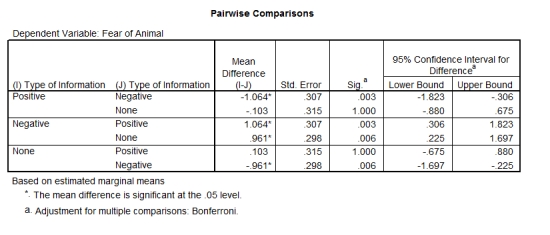A psychologist was interested in the effects of different fear information on children's beliefs about an animal.Three groups of children were shown a picture of an animal that they had never seen before (a quoll) .Then one group was told a negative story (in which the quoll is described as a vicious,disease-ridden bundle of nastiness that eats children's brains) ,one group a positive story (in which the quoll is described as a harmless,docile creature who likes nothing more than to be stroked) ,and a final group weren't told a story at all.After the story children rated how scared they would be if they met a quoll,on a scale ranging from 1 (not at all scared) to 5 (very scared indeed) .To account for the natural anxiousness of each child,a questionnaire measure of trait anxiety was given to the children and used in the analysis.The SPSS output is below.What analysis has been used? 


Definitions:
Reactivity
The phenomenon wherein individuals modify their behavior in response to the awareness that they are being observed.
Content Validity
The extent to which a test measures all aspects of the concept it intends to measure.
Face Validity
The extent to which a test or measure appears to be valid on the surface, based on subjective judgment.
Concurrent Validity
The degree to which the results of a particular test correlate with those of a previously established test or measure, assessed at the same time.
Q2: McNemar's test can be used to determine
Q4: A Type II error occurs when :<br>A)We
Q5: A psychologist was interested in whether the
Q5: What does independence of data mean?<br>A) That
Q10: The statistical implication of using a parsimony
Q14: What do you deduce about this distribution?
Q21: A psychologist was interested in whether the
Q24: A repeated-measures ANOVA is the same as
Q24: A female Year 10 student scored 940/1250
Q44: In which sub-dialog box can the chi-square